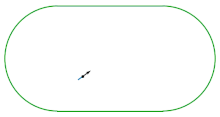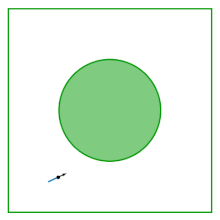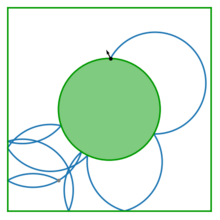
A | B | C | D | E | F | G | H | CH | I | J | K | L | M | N | O | P | Q | R | S | T | U | V | W | X | Y | Z | 0 | 1 | 2 | 3 | 4 | 5 | 6 | 7 | 8 | 9

A dynamical billiard is a dynamical system in which a particle alternates between free motion (typically as a straight line) and specular reflections from a boundary. When the particle hits the boundary it reflects from it without loss of speed (i.e. elastic collisions). Billiards are Hamiltonian idealizations of the game of billiards, but where the region contained by the boundary can have shapes other than rectangular and even be multidimensional. Dynamical billiards may also be studied on non-Euclidean geometries; indeed, the first studies of billiards established their ergodic motion on surfaces of constant negative curvature. The study of billiards which are kept out of a region, rather than being kept in a region, is known as outer billiard theory.
The motion of the particle in the billiard is a straight line, with constant energy, between reflections with the boundary (a geodesic if the Riemannian metric of the billiard table is not flat). All reflections are specular: the angle of incidence just before the collision is equal to the angle of reflection just after the collision. The sequence of reflections is described by the billiard map that completely characterizes the motion of the particle.
Billiards capture all the complexity of Hamiltonian systems, from integrability to chaotic motion, without the difficulties of integrating the equations of motion to determine its Poincaré map. Birkhoff showed that a billiard system with an elliptic table is integrable.
Equations of motion
The Hamiltonian for a particle of mass m moving freely without friction on a surface is:
where is a potential designed to be zero inside the region in which the particle can move, and infinity otherwise:
This form of the potential guarantees a specular reflection on the boundary. The kinetic term guarantees that the particle moves in a straight line, without any change in energy. If the particle is to move on a non-Euclidean manifold, then the Hamiltonian is replaced by:
where is the metric tensor at point . Because of the very simple structure of this Hamiltonian, the equations of motion for the particle, the Hamilton–Jacobi equations, are nothing other than the geodesic equations on the manifold: the particle moves along geodesics.
Notable billiards and billiard classes
Hadamard's billiards
Hadamard's billiards concern the motion of a free point particle on a surface of constant negative curvature, in particular, the simplest compact Riemann surface with negative curvature, a surface of genus 2 (a two-holed donut). The model is exactly solvable, and is given by the geodesic flow on the surface. It is the earliest example of deterministic chaos ever studied, having been introduced by Jacques Hadamard in 1898.
Artin's billiard
Artin's billiard considers the free motion of a point particle on a surface of constant negative curvature, in particular, the simplest non-compact Riemann surface, a surface with one cusp. It is notable for being exactly solvable, and yet not only ergodic but also strongly mixing. It is an example of an Anosov system. This system was first studied by Emil Artin in 1924.
Dispersing and semi-dispersing billiards
Let M be complete smooth Riemannian manifold without boundary, maximal sectional curvature of which is not greater than K and with the injectivity radius . Consider a collection of n geodesically convex subsets (walls) , , such that their boundaries are smooth submanifolds of codimension one. Let , where denotes the interior of the set . The set will be called the billiard table. Consider now a particle that moves inside the set B with unit speed along a geodesic until it reaches one of the sets Bi (such an event is called a collision) where it reflects according to the law “the angle of incidence is equal to the angle of reflection” (if it reaches one of the sets , , the trajectory is not defined after that moment). Such dynamical system is called semi-dispersing billiard. If the walls are strictly convex, then the billiard is called dispersing. The naming is motivated by observation that a locally parallel beam of trajectories disperse after a collision with strictly convex part of a wall, but remain locally parallel after a collision with a flat section of a wall.
Dispersing boundary plays the same role for billiards as negative curvature does for geodesic flows causing the exponential instability of the dynamics. It is precisely this dispersing mechanism that gives dispersing billiards their strongest chaotic properties, as it was established by Yakov G. Sinai.[1] Namely, the billiards are ergodic, mixing, Bernoulli, having a positive Kolmogorov-Sinai entropy and an exponential decay of correlations.
Chaotic properties of general semi-dispersing billiards are not understood that well, however, those of one important type of semi-dispersing billiards, hard ball gas were studied in some details since 1975 (see next section).
General results of Dmitri Burago and Serge Ferleger[2] on the uniform estimation on the number of collisions in non-degenerate semi-dispersing billiards allow to establish finiteness of its topological entropy and no more than exponential growth of periodic trajectories.[3] In contrast, degenerate semi-dispersing billiards may have infinite topological entropy.[4]
Lorentz gas, a.k.a. Sinai billiard

The table of the Lorentz gas (also known as Sinai billiard) is a square with a disk removed from its center; the table is flat, having no curvature. The billiard arises from studying the behavior of two interacting disks bouncing inside a square, reflecting off the boundaries of the square and off each other. By eliminating the center of mass as a configuration variable, the dynamics of two interacting disks reduces to the dynamics in the Sinai billiard.
The billiard was introduced by Yakov G. Sinai as an example of an interacting Hamiltonian system that displays physical thermodynamic properties: almost all (up to a measure zero) of its possible trajectories are ergodic and it has a positive Lyapunov exponent.
Sinai's great achievement with this model was to show that the classical Boltzmann–Gibbs ensemble for an ideal gas is essentially the maximally chaotic Hadamard billiards.
Bouncing ball billiard
A particle is subject to a constant force (e.g. the gravity of the Earth) and scatters inelastically on a periodically corrugated vibrating floor. When the floor is made of arc or circles - in a ceratin intervall of frequencies - one can give a semi-analytic estimates to the rate of exponential separation of the trajectories.[5]
Bunimovich stadium
The table called the Bunimovich stadium is a rectangle capped by semicircles, a shape called a stadium. Until it was introduced by Leonid Bunimovich, billiards with positive Lyapunov exponents were thought to need convex scatters, such as the disk in the Sinai billiard, to produce the exponential divergence of orbits. Bunimovich showed that by considering the orbits beyond the focusing point of a concave region it was possible to obtain exponential divergence.
Magnetic billiards

Magnetic billiards represent billiards where a charged particle is propagating under the presence of a perpendicular magnetic field. As a result, the particle trajectory changes from a straight line into an arc of a circle. The radius of this circle is inversely proportional to the magnetic field strength. Such billiards have been useful in real world applications of billiards, typically modelling nanodevices (see Applications).
Generalized billiards
Generalized billiards (GB) describe a motion of a mass point (a particle) inside a closed domain with the piece-wise smooth boundary . On the boundary the velocity of point is transformed as the particle underwent the action of generalized billiard law. GB were introduced by Lev D. Pustyl'nikov in the general case,[6] and, in the case when is a parallelepiped[7] in connection with the justification of the second law of thermodynamics. From the physical point of view, GB describe a gas consisting of finitely many particles moving in a vessel, while the walls of the vessel heat up or cool down. The essence of the generalization is the following. As the particle hits the boundary , its velocity transforms with the help of a given function , defined on the direct product (where is the real line, is a point of the boundary and is time), according to the following law. Suppose that the trajectory of the particle, which moves with the velocity , intersects at the point at time . Then at time the particle acquires the velocity , as if it underwent an elastic push from the infinitely-heavy plane , which is tangent to at the point , and at time moves along the normal to at with the velocity
Antropológia
Aplikované vedy
Bibliometria
Dejiny vedy
Encyklopédie
Filozofia vedy
Forenzné vedy
Humanitné vedy
Knižničná veda
Kryogenika
Kryptológia
Kulturológia
Literárna veda
Medzidisciplinárne oblasti
Metódy kvantitatívnej analýzy
Metavedy
Metodika
Text je dostupný za podmienok Creative
Commons Attribution/Share-Alike License 3.0 Unported; prípadne za ďalších
podmienok.
Podrobnejšie informácie nájdete na stránke Podmienky
použitia.
www.astronomia.sk | www.biologia.sk | www.botanika.sk | www.dejiny.sk | www.economy.sk | www.elektrotechnika.sk | www.estetika.sk | www.farmakologia.sk | www.filozofia.sk | Fyzika | www.futurologia.sk | www.genetika.sk | www.chemia.sk | www.lingvistika.sk | www.politologia.sk | www.psychologia.sk | www.sexuologia.sk | www.sociologia.sk | www.veda.sk I www.zoologia.sk





























